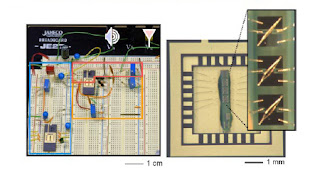Nanotube Radio
 The complete radio (left) and magnified views of nanotube transistors wire-bonded into standard packages (right) [Photo courtesy: John Rogers Research Group, University of Illinois, Urbana-Champaign]
The complete radio (left) and magnified views of nanotube transistors wire-bonded into standard packages (right) [Photo courtesy: John Rogers Research Group, University of Illinois, Urbana-Champaign]John Rogers and his colleagues from the University of Illinois, Urbana–Champaign, IL and Northrop Grumman Electronics Systems, Linthicum, MD have reported the development of the first practical transistor radio made entirely of carbon-nanotube based electronics.
Carbon nanotubes can be thought of as single sheets of graphite rolled up into tiny tubes. They are also semiconductors and thus have been used to create different electronic devices including tiny transistors and even a nanometre-size radio receiver. Because of their tiny size and high electrical and thermal conductivity, they could be used to create very small and extremely fast electronic circuits.
The team worked out a way to align thousands of the nanometre-diameter tubes in sheets in order to create electronic devices that can handle sufficiently large currents for practical use. Unlike previous nanotube radios, which produced very weak signals that needed further amplification, the team were able to listen to a local broadcast on headphones connected directly to a nanotube transistor. Since individual nanotubes in each transistor device operate in parallel and independently, the devices can produce large current outputs. This means that they can have high levels of gain and amplification in both the RF and audio frequency ranges.
More importantly, many devices can be produced at once and integrated into circuits. Such features were absent from nanoradios and other electronic devices that incorporated only single nanotubes. The team is now building medium-scale circuits containing up to 100 transistors and are also implementing advanced designs to improve the RF response and power efficiency of the systems.
Reference
"Radio frequency analog electronics based on carbon nanotube transistors"
Coskun Kocabas, Hoon-sik Kim, Tony Banks, John A. Rogers, Aaron A. Pesetski, James E. Baumgardner, S. V. Krishnaswamy, and Hong Zhang,
Proceedings of the National Academy of Sciences of the United States of America Published online on January 28, 2008, 10.1073/pnas.0709734105, Abstract Link


